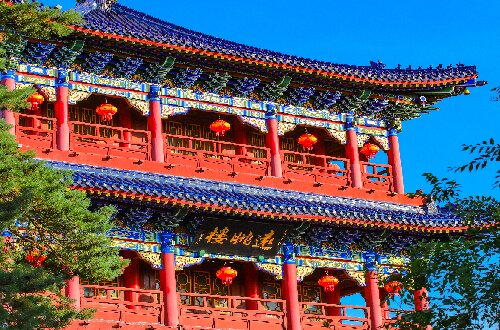Hongshan Park Scenic Area

Urumqi Hongshan Park is a natural mountain landscape park. It is named "Hongshan"(Red Mountain) because the cliff at the west end of the mountain is ochre red in color. The park seamlessly integrates natural scenery, cultural landscapes, historical heritage and recreational activities, offering visitors a comprehensive experience that combines sightseeing, fitness and entertainment.
- Chinese name: 红山公园 Hóng Shān Gōng Yuán
- Suggested time: Half a day to one day
- Ticket: Free
- Open hours: 07:00-24:00
- The best time to visit: May - October
- Address: No. 40, North First Lane, Hongshan Road, Shuimogou District, Urumqi, Xinjiang
- How to get there: You can take bus lines 29, 35, 61, 62, 63, 73, 908, 927 and get off at Hongshan Park Station.
- Surroundings: Shuimogou Scenic Spot
Highlights of Hongshan Park Scenic Area
Hongshan Tower
Hongshan Tower was first constructed in the 53rd year of the Qianlong Emperor's reign during the Qing Dynasty (1788). It is a pavilion-style, six-sided solid blue brick tower with a height of 10.6 meters and nine stories, featuring an elegant and intact architectural design. Originally blue-gray in color, the tower was repainted red in 1988. As the sole remaining Qing Dynasty structure on Hongshan Mountain, it has withstood over 200 years of harsh wind and snow beyond the Great Wall, as well as numerous strong earthquakes, yet remains perfectly preserved. Hongshan Park serves as an excellent vantage point to overlook the entire city of Urumqi. Ascending Hongshan Tower offers a panoramic view of the cityscape, and on clear days, visitors may even catch a glimpse of the majestic Bogda Peak in the distance.
Yuanwang Tower
 Yuanwang Tower
Yuanwang TowerYuanwang Tower is an antique-style building. With the rapid development of Urumqi, the small pavilion can no longer meet the tourists' viewing needs, so the Yuanwang Tower was rebuilt in 1992. Yuanwang Tower is three stories high (21.95 meters), surrounded by a long corridor with carved beams and painted buildings. Inside, it features an exhibition of Urumqi’s urban construction photos and two sand-table models of the old and new cityscapes. For a 10-yuan admission fee, visitors can climb to the top, lean on the railing, and enjoy the scenery.
Great Buddha Temple
Great Buddha Temple is part of an ancient Qing Dynasty temple complex. It was restored to its former glory through reconstruction in 1989. The temple consists of six main halls: the Heavenly King Hall, Mahavira Hall, Guanyin Hall, Ksitigarbha Hall, Wealth God Hall and Thousand-hand Guanyin Hall. The sacred statues enshrined here include Sakyamuni, Maitreya Buddha, Guanyin (Avalokiteshvara), Ksitigarbha (Dizang), the Four Heavenly Kings and the Eighteen Arhats. With solemn Buddha statues and curling incense smoke, the temple offers a rare haven of tranquility amid the bustling city. As a Han Chinese Buddhist temple, it embodies the profound heritage of Chinese national culture.
Educational Value
Hongshan (Red Mountain) is located near the Urumqi Fault Zone and has a history of significant seismic influence. During the Qianlong reign of the Qing Dynasty (1785), an earthquake caused mountain collapse. The existing "Zhenlong Pagoda" (Hongshan Tower), built as part of the post-earthquake restoration project, serves as a tangible example for studying earthquake disasters and geological stability.
Activities to do at Hongshan Park Scenic Area
Geological Science Research and Study: Students analyze the geological origins of Hongshan by observing rock strata and collecting soil samples.
Recreational Activities: Take walks or go boating along the artificial lakes in the park (such as South Lake). In winter, engage in ice activities like ice sledding and ice cycling.
Yoga and Morning Exercises: In the early morning, yoga and tai chi classes are organized on the mountain-top platform or in forest clearings, combining fresh air and broad vistas to enhance the exercise experience.
Drop us a line and we'll connect you with the top China expert in no time!